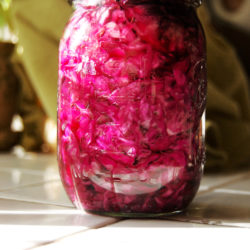
Homemade Lactofermented Sauerkraut
Sauerkraut is the best first ferment for someone starting to dabble in making their own probiotic vegetables at home!
Ingredients
- 1 medium cabbage cored and finely shredded (purple if you desire)
- 1 tablespoon caraway seeds omit for AIP
- 1 tablespoon sea salt
- 2 tablespoons whey see note below for sourcing. If not available or AIP, use an additional 1 tablespoon sea salt in its place
Instructions
-
In a bowl, mix cabbage with caraway seeds, sea salt and whey.
-
Pound with a wooden pounder or a meat hammer (or the clean bottom of a bottle of wine!) for about ten minutes to release juices, and/or squeeze and knead the cabbage with your hands. The cabbage should release a lot of liquid. If it doesn't, keep working!
-
Place in a quart-sized, wide-mouth mason jar and press down firmly with a pounder or the bottom of a wooden spooen until the juices come to the top and cover the cabbage. You are trying to make sure there are no air pockets in the shredded cabbage in the jar. The top of the cabbage and liquid should be at least 1 inch below the top of the jar.
-
Put a lid on tightly and keep at room temperature for about 7 days (or, you can ferment up to 1 month) before transferring to the fridge for storage. The sauerkraut may be eaten immediately, but it improves with age.
Recipe Notes
*want to use whey, but don't know where to get it? Yeah, you can't buy it, but you can make it! Take 2 cups of whole milk yogurt, and place in a colander or strainer lined with a clean dishtowel. Put the colander over a bowl big enough to catch the liquid that drips from the straining yogurt. Put the whole thing in the fridge, and allow to strain for at least 2 to 4 hours, or overnight. Save the liquid that drains away from the yogurt, because this is the whey! You can put it in a mason jar with a lid and it should keep in the fridge for up to 6 months. The strained yogurt is now what you would consider Greek yogurt--extra thick and creamy! Eat it as you would any normal yogurt.